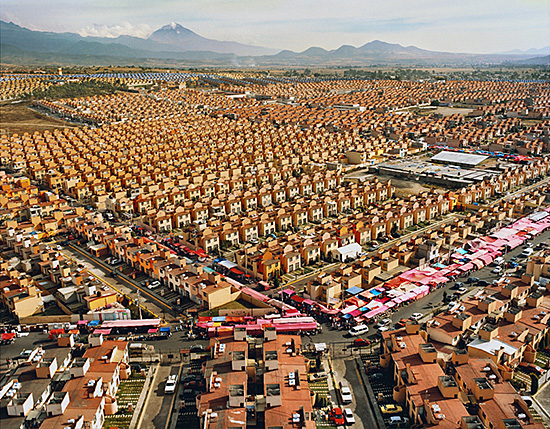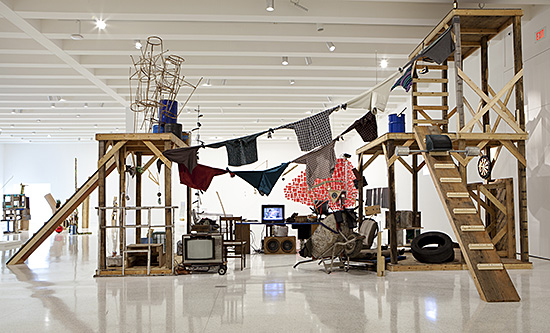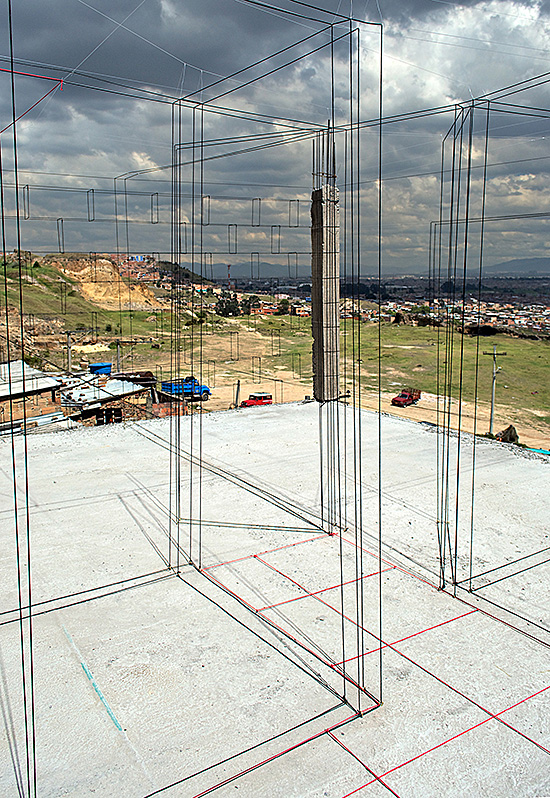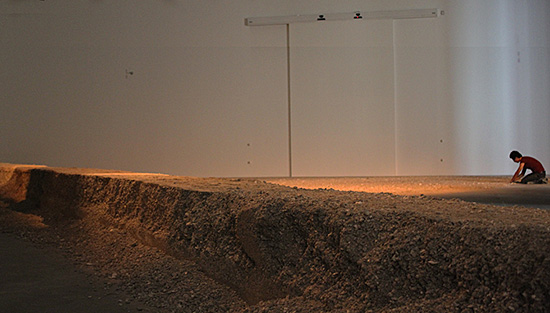July 1, 2015
Affective Constructions:
Notes on Housing and Art
Written by Claudia Arozqueta
I.
Houses are intimate spaces, a shelter where the self is nourished and protected, and identity rebuilds itself on a daily basis. But besides being a cradle of affection and a social space, houses also reflect economical, political and cultural aspects. Acquiring an adequate house is one of the most complicated vital tasks generated of our times, especially since a profit driven economy spreads its malaises around the world. For instance, in Latin America the situation is complex and worrying as one of the common denominators for decades has been housing shortage.
According to studies of the Inter-American Development Bank, one of three families in Latin America and the Caribbean live in inadequate housing, constructed with very precarious and faulty materials, most of them settled in marginal areas not suitable for habitation, lacking the most basic services such as sanitation, water supply, and garbage collection. The urban expansion in Latin America has resulted in social disparities. The urban space in capitals like Santiago de Chile, Bogotá, or Mexico City is deeply fragmented and characterized by gentrification and polarization. Some of the improvised neighborhoods have wealthy vicinities where houses can cost millions of dollars and have plenty of services.

This urban landscape has caught the attention of some artists, which have decided to work on the aesthetics, processes and community work that is generated in challenged neighborhoods. Their work offers a view of spaces that are the product of uncontrolled urbanization and social segregation, but that are also centers where social bonds are created and where self-learning, invention and communication are encouraged.
II.
Since the fifties, the massive growth of population and an accelerated rate of industrialization have pushed people from the countryside into the cities of Latin America. Many of them have settled in unused lands at the outskirts, self-building their own houses, developing then irregular settlements that later become suburbs. In this process there are no architects or urban and ecological planning, but grass roots communities, home made skills and non-specialized labor. Communities construct for themselves what modernity failed to deliver.

Artist Abraham Cruzvillegas narrates the process of construction of most of these houses in his book Autoconstrucción (2008):
Every weekend there was a festive air around the dusty activities of moving chalk, cement and sand; the women would cook and help to carry water, haul stones, bricks, bags of cement, buckets of sand or fizzy drinks, under a burning sun, in a challenging atmosphere moved by a spirit of busy and efficient collectivity. On what years later would become known as streets, the men and women of the community would stir the huge bowl of cement to the rhythm of cumbias, songs by José José, ranchera ballads, and there would be no shortage of beer, pulque or fruit juices to keep it all going.
This is a first-hand account: Cruzvillegas’s family migrated from the South of Mexico and joined a group of people that squatted in the unused lands of Ajusco, in Mexico City. With the help of relatives and neighbors his parents self-built their own house with whatever materials were available. In these construction processes, with their improvisation and amalgamation of objects, Cruzvillegas saw both a powerful aestheticand a form of experience.
His continuous and polymorphous project titled Autoconstrucción [Self-construction] (2007-) is a direct result of this construction methodology. The artist collects materials that randomly fuse to create both small sculptures and large-scale interventions, but also poems, films and songs. Cruzvillegas’s relation with materials seems to derive from Duchamp’s strategy of “let the objects play or couple,” creating in this manner spatial connections or disconnections, meaningful possibilities out of seemingly poor,contradictory or inadequate elements. Cruzvillegas’s work implies a critical discourse on the reality of housing in Mexico, and the corresponding vulnerability of citizens that face the lack of reliable and commited urban state planning.
III.
Self-built houses are a flux, a never-ending state of construction and destruction, caught in a loop of incompleteness, hanging from the threads of necessity, possibility, and imagination.

In Architecture Without Architects (2012-14), artist Sandra Calvo engages the fragility implied in any self-built home. Together with a family living in the peripheries of Bogota, Colombia, the artist created a playful method for the visualization of the family’s house desired future expansion. The desired spaces were marked and projected as a 3-dimensional drawing using two colors of strings that would help them take decisions and foresee possible problems during the construction. Black threads marked those areas where the family had consensus; red highlighted the elements where there was differences of opinion. Strings acted as a multilayered material: as an element of construction and communication that holds disintegrated ideas and gives them form, also implying not only the political but also poetical spirit of collaborative participation.
The artist documented the process in video, created a film and video installations that incorporated self-construction materials. Also, a replica of the in situ installation was conceived for museographic spaces but dislocated into the white cube it appears more as a formal study, losing somehow its sense of specificity and collective work. However, the most remarkable aspect of this project are the very simple gestures and materials that show the positive social and practical effects of an understanding between individuals and affective work.
IV.
In the last two decades, housing has become a key component of the political agenda for Latin American governments. In Mexico for example, since the year 2000, federal and local governments have created programs, giving facilities to real estate investors for the creation of houses for the middle and low-income population. But the creation of a sea of nightmarish massive serial houses has proved in more than one occasion to be more a problem than a solution. These constructions deteriorate the environment, annulling then for their inhabitants any degree or reasonable wellbeing.
These houses have been documented by artist Livia Corona in her series Two Million Homes for Mexico (2006-), which depict their paradoxically seriatim but distant nature: isolated in lands not adequate for building and where there is no infrastructure—no schools, parks, commerce, effective transport and even services such as electricity or water, and constructed with bad quality materials—more than 5 million houses have been abandoned across different regions of the country. Evidently, these constructions are a failed alternative to self-built and improvised houses because they don’t offer better living conditions. On the contrary, they are a worrisome epidemy that expands and which only benefits real-estate developers in disregard of the environment and the people they mendaciously propose to help.

V.
The illusion of owning a house and better opportunities dissolve for many people trapped in the vicious circle of low wages and low-quality unliveable houses that come with subsequent debts and chronic unemployment. Teresa Margolles’s installation The Promise (2012-13) is a statement of this broken opportunities pledge. This site-specific 115-foot-wide mound of debris is shaped like a mass grave and consists of what once was a low-income house in the suburbs of the border city of Ciudad Juárez.
In the past decade, migrants, especially women, who have left different regions in Mexico to escape poverty, have settled in Ciudad Juárez to work at the maquiladoras. Once a land of promises, Ciudad Juárez is now a place where crimes mostly related to drug trafficking have increased dramatically and where the labor market has been reduced to the point that people are forced to emigrate, leaving some 111,000 homes abandoned.
Dismantled over eleven days, the rubbles of this home have been exhibited in different organizations being painstakingly and almost ritually displaced day by day by a group of volunteers. By the end of the exhibition, the debris pervades the entire exhibition space, resembling the sands of Ciudad Juárez’s desert, in which dreams and lives of people dissolve like dust into anonymity. Thus the work is a kind of theatrical mirror of the death and abandonment pervading contemporary culture.
VI.
In this current climate, no matter how relevant an artist’s work is within the culture and art circuit, even if it reaches international audiences; it cannot have a perdurable and effective positive impact that could ameliorate the dire situation of millions of people. Meanwhile, one may recognize the importance of sharing and exposing to wider audiences the local precariousness of urban logistics and its quotidian burden imposed on less privileged citizens. Indeed, this can be achieved when specific aspects of the urban become politicized, even as a result of an aesthetic exploration, which therefore invites temporary participation of other layers of society.
Participatory approaches, in which communities are encouraged to develop a social bond towards their own social, ecological and political environment, are to be considered as perhaps the best possible manner to ameliorate, thanks to creativity and imagination, the current state of challenged neighborhoods. A good example is Project Morrinho (1998-) in Rio de Jainero, Brazil, in which a group of kids reproduced the reality of favelas with bricks and remains of paint in a backyard, resulting in a miniature reproduction of it in all senses, attracting the attention of other creative people that invited them to create a documentary, exhibit their work at the São Paulo Biennale. Something that started as a kid’s play became a collective work of art, and developed in a multidisciplinary organization that changed the self-perception of an entire neighborhood.
Art, playfulness and social commitment can create spontaneous but powerful changes for the most challenging situations. Socially engaged art is far from delivering concrete solutions to the people in need of better housing or public infrastructure. But at least, it can shed some light on the existing inefficient public strategies for public housing, exacerbated by corruption, negligence or plain ineptitude, that are still far away from satisfying a very simple demand: a roof, under which is possible to live in a dignified manner.
Claudia Arozqueta is a curator, writer and researcher. Her writing has been published in various international magazines, books and journals, including Leonardo MIT, Artforum, Art-agenda, Flash Art and the Journal of Science and Technology of the Arts. She has curated a number of exhibitions in Mexico, New Zealand, France, Russia, Japan and Australia. Arozqueta is also co-founder and co-curator of Modelab.
[1] More information in the Inter-American Development Bank’s release on housing in Latin America, available at: http://www.iadb.org/en/news/news-releases/2012-05-14/housing-deficit-in-latin-america-and-caribbean,9978.html
[2] Abraham Cruzvillegas, Autoconstrucción (Glasgow: Centre for Contemporary Arts, 2008) 18.
[3] In Mexico at least 25 million people inhabit houses in areas prone to high floods or extreme droughts. Ciffres from OECD (2015), OECD Urban Policy Reviews: Mexico 2015: Transforming Urban Policy and Housing Finance, OECD Publishing, Paris. DOI: http://dx.doi.org/10.1787/9789264227293-en
[4] Ibid.









